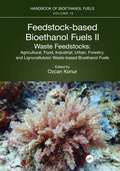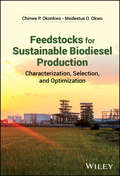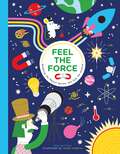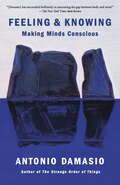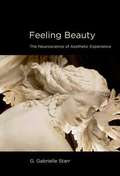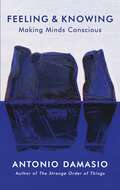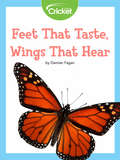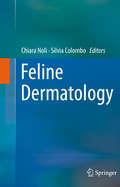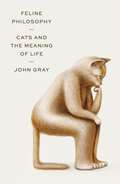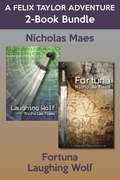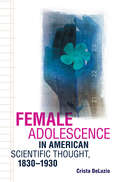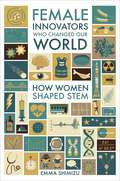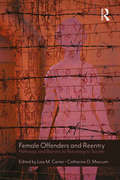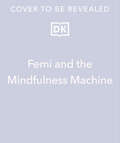- Table View
- List View
Feedstock-based Bioethanol Fuels. II. Waste Feedstocks: Agricultural, Food, Industrial, Urban, Forestry, and Lignocellulosic Waste-based Bioethanol Fuels
by Ozcan KonurThis book provides an overview of research on the production of bioethanol fuels from waste feedstocks such as second-generation residual sugar and starch feedstocks, food waste, industrial waste, urban waste, forestry waste, and lignocellulosic biomass at large with 17 chapters. In this context, there are eight sections where the first two chapters cover the production of bioethanol fuels from waste feedstocks at large. This book is the fourth volume in the Handbook of Bioethanol Fuels (Six-Volume Set). It shows that pretreatments and hydrolysis of the waste feedstocks, fermentation of hydrolysates, and separation and distillation of bioethanol fuels are the fundamental processes for bioethanol fuel production from these waste feedstocks. This book is a valuable resource for stakeholders primarily in research fields of energy and fuels, chemical engineering, environmental science and engineering, biotechnology, microbiology, chemistry, physics, mechanical engineering, agricultural sciences, food science and engineering, materials science, biochemistry, genetics, molecular biology, plant sciences, water resources, economics, business and management, transportation science and technology, ecology, public, environmental and occupational health, social sciences, toxicology, multi-disciplinary sciences, and humanities among others.
Feedstocks for Sustainable Biodiesel Production: Characterization, Selection, and Optimization
by Modestus O. Okwu Chinwe P. OkonkwoComplete and practical guidance on using biodegradable feedstocks for biodiesel production Feedstocks for Sustainable Biodiesel Production: Characterization, Selection, and Optimization helps readers understand the advantages, challenges, and potential of different biodegradable feedstock options that can be used in biodiesel production, covering methods of feedstock sourcing extraction, environmental concerns, cost-benefit aspects, practical applications, and more. Specific biodegradable feedstocks covered in this text include chrysobalamus icaco, cussonia bateri, elaeis guineensis, waste cooking oils, moringa oleifera, jatropha curcas, chlorophyceae (unicellular green algae), fucus vesiculosus (micro algae), afzelia africana, cucurbita pepo, hura crepitans, cuyperus esculentus, colocynthus vulgaris, and others. This book explores topics such as: Key characteristics of biodiesel, using biodiesel as an alternative to petroleum diesel, and a review of the latest industry standards, practices, and trends Basis of the selection of specific (including nonedible) feedstocks for different applications and the addition of new, innovative feedstocks in recent years Specific sustainability benefits of nonedible feedstocks, which can be grown on abandoned land where they do not compete with food crops Government policies aimed at finding fossil fuel alternatives which will increase biodegradable feedstock adoption Experimental and predictive modeling of biodiesel produced from novel feedstocks using computational intelligence techniques Providing both core foundational knowledge on the subject as well as insight on how to practically transition away from fossil fuels, this book is an essential reference for engineering professionals with a specific interest in biodiesel production, sustainability, renewable energy, and environmental conservation.
Feel the Force: Revealing the Physics Secrets that Rule the Universe
by Mike BarfieldFollowing The Element in the Room and That's Life!, this fun and beautiful book will have young scientists unlocking the world of Physics, seeing how the same physical laws which govern the wider universe are also at play much closer to home. Covering motion, forces, gravity, matter, energy and much more, this engaging and accessible guide includes comic strips to bring the stories of great scientists and their discoveries to life and hands-on experiments to have fun with at home. Get ready for an adventure as Sherlock Ohms and friends reveal the rules that run the universe!
Feeling & Knowing: Making Minds Conscious
by Antonio DamasioFrom one of the world&’s leading neuroscientists: a succinct, illuminating, wholly engaging investigation of how biology, neuroscience, psychology, and artificial intelligence have given us the tools to unlock the mysteries of human consciousness In recent decades, many philosophers and cognitive scientists have declared the problem of consciousness unsolvable, but Antonio Damasio is convinced that recent findings across multiple scientific disciplines have given us a way to understand consciousness and its significance for human life. In the forty-eight brief chapters of Feeling & Knowing, and in writing that remains faithful to our intuitive sense of what feeling and experiencing are about, Damasio helps us understand why being conscious is not the same as sensing, why nervous systems are essential for the development of feelings, and why feeling opens the way to consciousness writ large. He combines the latest discoveries in various sciences with philosophy and discusses his original research, which has transformed our understanding of the brain and human behavior. Here is an indispensable guide to understanding how we experience the world within and around us and find our place in the universe.
Feeling Beauty
by G. Gabrielle StarrIn Feeling Beauty, G. Gabrielle Starr argues that understanding the neural underpinnings of aesthetic experience can reshape our conceptions of aesthetics and the arts. Drawing on the tools of both cognitive neuroscience and traditional humanist inquiry, Starr shows that neuroaesthetics offers a new model for understanding the dynamic and changing features of aesthetic life, the relationships among the arts, and how individual differences in aesthetic judgment shape the varieties of aesthetic experience. Starr, a scholar of the humanities and a researcher in the neuroscience of aesthetics, proposes that aesthetic experience relies on a distributed neural architecture -- a set of brain areas involved in emotion, perception, imagery, memory, and language. More important, it emerges from networked interactions, intricately connected and coordinated brain systems that together form a flexible architecture enabling us to develop new arts and to see the world around us differently. Focusing on the "sister arts" of poetry, painting, and music, Starr builds and tests a neural model of aesthetic experience valid across all the arts. Asking why works that address different senses using different means seem to produce the same set of feelings, she examines particular works of art in a range of media, including a poem by Keats, a painting by van Gogh, a sculpture by Bernini, and Beethoven's Diabelli Variations. Starr's innovative, interdisciplinary analysis is true to the complexities of both the physical instantiation of aesthetics and the realities of artistic representation.
Feeling Beauty: The Neuroscience of Aesthetic Experience
by G. Gabrielle StarrA theory of the neural bases of aesthetic experience across the arts, which draws on the tools of both cognitive neuroscience and traditional humanist inquiry.In Feeling Beauty, G. Gabrielle Starr argues that understanding the neural underpinnings of aesthetic experience can reshape our conceptions of aesthetics and the arts. Drawing on the tools of both cognitive neuroscience and traditional humanist inquiry, Starr shows that neuroaesthetics offers a new model for understanding the dynamic and changing features of aesthetic life, the relationships among the arts, and how individual differences in aesthetic judgment shape the varieties of aesthetic experience. Starr, a scholar of the humanities and a researcher in the neuroscience of aesthetics, proposes that aesthetic experience relies on a distributed neural architecture—a set of brain areas involved in emotion, perception, imagery, memory, and language. More important, it emerges from networked interactions, intricately connected and coordinated brain systems that together form a flexible architecture enabling us to develop new arts and to see the world around us differently. Focusing on the "sister arts" of poetry, painting, and music, Starr builds and tests a neural model of aesthetic experience valid across all the arts. Asking why works that address different senses using different means seem to produce the same set of feelings, she examines particular works of art in a range of media, including a poem by Keats, a painting by van Gogh, a sculpture by Bernini, and Beethoven's Diabelli Variations. Starr's innovative, interdisciplinary analysis is true to the complexities of both the physical instantiation of aesthetics and the realities of artistic representation.
Feeling and Knowing: Making Minds Conscious
by Antonio DamasioIn recent decades, many philosophers and cognitive scientists have declared the question of consciousness unsolvable, but Antonio Damasio is convinced that recent findings in neuroscience, psychology and artifical intelligence have given us the necessary tools to solve its mystery. In Feeling & Knowing, Damasio elucidates the myriad aspects of consciousness and presents his analysis and new insights in a way that is faithful to our own intuitive sense of the experience.In forty-eight brief chapters, Damasio helps us understand the relation between consciousness and the mind; why being conscious is not the same as either being awake or sensing; the central role of feeling; and why the brain is essential for the development of consciousness. He synthesises the recent findings of various sciences with the philosophy of consciousness, and, most significantly, presents his original research which has transformed our understanding of the brain and human behaviour.Here is an indispensable guide to understanding the fundamental human capacity for informing and transforming our experience of the world around us and our perception of our place in it.
Feeling and Knowing: Making Minds Conscious
by Antonio DamasioIn recent decades, many philosophers and cognitive scientists have declared the question of consciousness unsolvable, but Antonio Damasio is convinced that recent findings in neuroscience, psychology and artifical intelligence have given us the necessary tools to solve its mystery. In Feeling & Knowing, Damasio elucidates the myriad aspects of consciousness and presents his analysis and new insights in a way that is faithful to our own intuitive sense of the experience.In forty-eight brief chapters, Damasio helps us understand the relation between consciousness and the mind; why being conscious is not the same as either being awake or sensing; the central role of feeling; and why the brain is essential for the development of consciousness. He synthesises the recent findings of various sciences with the philosophy of consciousness, and, most significantly, presents his original research which has transformed our understanding of the brain and human behaviour.Here is an indispensable guide to understanding the fundamental human capacity for informing and transforming our experience of the world around us and our perception of our place in it.
Feelings in Sport: Theory, Research, and Practical Implications for Performance and Well-being (Routledge Psychology of Sport, Exercise and Physical Activity)
by Montse C. Ruiz Claudio RobazzaFeeling states, including emotional experiences, are pervasive to human functioning. Feeling states deeply influence the individual’s effort, attention, decision making, memory, behavioural responses, and interpersonal interactions. The sporting environment offers an ideal setting for the development of research questions and applied interventions to improve the well-being and well-functioning of the people involved. This ground-breaking book is the first to offer cutting-edge knowledge about contemporary theoretical, methodological, and applied issues with the contributions of leading researchers and practitioners in the field. Feeling states in sports are comprehensively covered by adopting an international and multi-disciplinary perspective. Part I covers most relevant conceptual frameworks, including emotion-centred and action-centred approaches, challenge and threat evaluations, an evolutionary approach to emotions, and the role of passion in the experience of emotion. Part II focuses on interpersonal aspects related to emotions and regulation, encompassing social and interpersonal emotion influence and regulation, social identity and group-based emotions, and performance experiences in teams. Part III presents applied indications surrounding emotional intelligence training, and emotional regulation strategies including imagery, self-talk, the use of music, mindfulness, motor skills execution under pressure, self-regulation in endurance sports, and the use of technology. Finally, Part IV examines issues related to athlete well-being, including the role of emotions in sport injury, emotional eating, and mental recovery. Feelings in Sport: Theory, Research, and Practical Implications for Performance and Well-being is an essential source for sport psychology practitioners, researchers, sports coaches, undergraduate and postgraduate students.
Feelings in Sport: Theory, Research, and Practical Implications for Performance and Well-being (Routledge Psychology of Sport, Exercise and Physical Activity)
by Claudio Robazza Montse RuizFeeling states, including emotional experiences, are pervasive to human functioning. Feeling states deeply influence the individual’s effort, attention, decision making, memory, behavioural responses, and interpersonal interactions. The sporting environment offers an ideal setting for the development of research questions and applied interventions to improve the well-being and well-functioning of the people involved. This ground-breaking book is the first to offer cutting-edge knowledge about contemporary theoretical, methodological, and applied issues with the contributions of leading researchers and practitioners in the field. Feeling states in sports are comprehensively covered by adopting an international and multi-disciplinary perspective. Part I covers most relevant conceptual frameworks, including emotion-centred and action-centred approaches, challenge and threat evaluations, an evolutionary approach to emotions, and the role of passion in the experience of emotion. Part II focuses on interpersonal aspects related to emotions and regulation, encompassing social and interpersonal emotion influence and regulation, social identity and group-based emotions, and performance experiences in teams. Part III presents applied indications surrounding emotional intelligence training, and emotional regulation strategies including imagery, self-talk, the use of music, mindfulness, motor skills execution under pressure, self-regulation in endurance sports, and the use of technology. Finally, Part IV examines issues related to athlete well-being, including the role of emotions in sport injury, emotional eating, and mental recovery. Feelings in Sport: Theory, Research, and Practical Implications for Performance and Well-being is an essential source for sport psychology practitioners, researchers, sports coaches, undergraduate and postgraduate students.
Feet That Taste, Wings That Hear
by Damian FaganLike other wildlife, butterflies use different senses to find food and mates and to watch out for predators. But how they see, smell, taste, touch, and hear is very different from other animals.
Feet!
by Peter ParnallLooks at a variety of animal feet, from big feet and fast feet to cool feet and webbed feet.
Fehler vor, während und nach der Wärmebehandlung von Stahl
by Peter SommerEine Vielzahl an Stahlbauteilen wird zur Eigenschaftsveränderung einer Wärmebehandlung unterzogen. Dieses praxisbezogene Buch gibt einen anschaulichen Überblick über die unterschiedlichen Einflussbereiche im Lebenszyklus solcher Produkte - von der Konstruktion bis zum Einsatz. Anhand zahlreicher Beispiele wird aufgezeigt, welche Fehlerquellen im Zusammenhang mit einer Wärmebehandlung auftreten können und wie diese vermieden werden. Dabei schöpft der Autor aus seiner jahrzehntelangen Erfahrung im Bereich der technischen Schadensanalyse und bietet Studierenden wie Praktiker*innen eine wertvolle Hilfestellung.
Fehlerfrei durch die ICP Emissionsspektrometrie
by Joachim NölteDas bewährte Konzept der Fallstricke - jetzt auch für ICP! Eingängige, hervorragend durchdachte Kombinationen von Bildmaterial und knappen, aber aussagekräftigen Texten vermitteln die gewünschte Lösung ohne Umwege.
Feldspar Minerals: 2 Chemical and Textural Properties
by J.V. Smith33 14. 3. 5 REE between Plagioclase and Aqueous Fluid 0 Cullers et al. (1973) measured the distribution of REE at 850 C and 750 bars pressure between a natural plagioclase, An , and gaseous water. The rare earths 65 favored the plagioclase by a factor which varies from about 25 for Ce to 10 for Lu. Data were also obtained for forsterite, diopside, enstatite and two rhyolite glasses, on the one hand, and water on the other hand, thereby permitting estimation of the partition coefficients between all pairs of phases. 14. 4 Chemical Substitution in Natural Feldspars 14. 4. 1 Introduction It is quite impracticable to give all the data on chemical substitution in natural feldspars: indeed many of the details are significant only to some particular pegmatite or rock body. As far as possible, emphasis is placed on features of general interest to crystal chemists and to petrologists. Ironically the well established features can be described more easily than the uncertain ones, and unfortunately it is necessary to use valuable space on data of dubious value. The bibliography is fairly complete, but it was impracticable to locate all data, especially those in obscure journals. Each reference is followed by a list of the elements referred to in the paper, thereby permitting a reader to compile a fairly compre hensive set of references on any chosen element. Not all papers are mentioned in the text. The book on Geochemistry and Mineralogy of Rare Elements, etc.
Feline Dermatology
by Chiara Noli Silvia ColomboThis richly-illustrated handbook covers all aspects of modern feline dermatology, from the approach to different signs and symptoms to the description of the etiology, pathogenesis, clinical manifestation, diagnosis and current treatment of each feline dermatological disease. Thus this manual serves as essential practical guide to the busy practitioner to quickly and surely tackle cats with dermatological conditions, and offers a current and complete reference tool for the feline veterinarian and the veterinary dermatologist.
Feline Philosophy: Cats and the Meaning of Life
by John GrayThe author of Straw Dogs, famous for his provocative critiques of scientific hubris and the delusions of progress and humanism, turns his attention to cats—and what they reveal about humans' torturous relationship to the world and to themselves. The history of philosophy has been a predictably tragic or comical succession of palliatives for human disquiet. Thinkers from Spinoza to Berdyaev have pursued the perennial questions of how to be happy, how to be good, how to be loved, and how to live in a world of change and loss. But perhaps we can learn more from cats--the animal that has most captured our imagination--than from the great thinkers of the world. In Feline Philosophy, the philosopher John Gray discovers in cats a way of living that is unburdened by anxiety and self-consciousness, showing how they embody answers to the big questions of love and attachment, mortality, morality, and the Self: Montaigne's house cat, whose un-examined life may have been the one worth living; Meo, the Vietnam War survivor with an unshakable capacity for "fearless joy"; and Colette's Saha, the feline heroine of her subversive short story "The Cat", a parable about the pitfalls of human jealousy. Exploring the nature of cats, and what we can learn from it, Gray offers a profound, thought-provoking meditation on the follies of human exceptionalism and our fundamentally vulnerable and lonely condition. He charts a path toward a life without illusions and delusions, revealing how we can endure both crisis and transformation, and adapt to a changed scene, as cats have always done.
Felix Taylor Adventures 2-Book Bundle: Laughing Wolf / Fortuna
by Nicholas MaesFor the first time, the Felix Taylor Adventures are available as together in this two-book bundle. Short-listed for the Snow Willow Young Reader’s Choice Award and the Manitoba Young Reader’s Choice Award. "An entertaining and thoughtful read that will please fans of sci-fi and historical fiction alike." - Caitlin Campbell, CM magazine Fortuna - Felix Taylor Adventure #2 (NEW!) Just when Felix thought the 23rd century was returning to normal, Felix and Caroline must follow a stranger back in time and stop them before Felix’s world turns to dust. Laughing Wold - Felix Taylor Adventure #1 When a mysterious plague places humanity on the brink of eradication, Felix must project back in time and retrieve the only possible cure, a flower common in ancient Rome, but extinct for more than 2,000 years.
Felt Time: The Psychology of How We Perceive Time
by Marc Wittmann Erik ButlerWe have widely varying perceptions of time. Children have trouble waiting for anything. ("Are we there yet?") Boredom is often connected to our sense of time passing (or not passing). As people grow older, time seems to speed up, the years flitting by without a pause. How does our sense of time come about? In Felt Time, Marc Wittmann explores the riddle of subjective time, explaining our perception of time -- whether moment by moment, or in terms of life as a whole. Drawing on the latest insights from psychology and neuroscience, Wittmann offers a new answer to the question of how we experience time.Wittmann explains, among other things, how we choose between savoring the moment and deferring gratification; why impulsive people are bored easily, and why their boredom is often a matter of time; whether each person possesses a personal speed, a particular brain rhythm distinguishing quick people from slow people; and why the feeling of duration can serve as an "error signal," letting us know when it is taking too long for dinner to be ready or for the bus to come. He considers the practice of mindfulness, and whether it can reduce the speed of life and help us gain more time, and he describes how, as we grow older, subjective time accelerates as routine increases; a fulfilled and varied life is a long life. Evidence shows that bodily processes -- especially the heartbeat -- underlie our feeling of time and act as an internal clock for our sense of time. And Wittmann points to recent research that connects time to consciousness; ongoing studies of time consciousness, he tells us, will help us to understand the conscious self.
Felt Time: The Psychology of How We Perceive Time
by Marc WittmannAn expert explores the riddle of subjective time, from why time speeds up as we grow older to the connection between time and consciousness. We have widely varying perceptions of time. Children have trouble waiting for anything. (“Are we there yet?”) Boredom is often connected to our sense of time passing (or not passing). As people grow older, time seems to speed up, the years flitting by without a pause. How does our sense of time come about? In Felt Time, Marc Wittmann explores the riddle of subjective time, explaining our perception of time—whether moment by moment, or in terms of life as a whole. Drawing on the latest insights from psychology and neuroscience, Wittmann offers a new answer to the question of how we experience time.Wittmann explains, among other things, how we choose between savoring the moment and deferring gratification; why impulsive people are bored easily, and why their boredom is often a matter of time; whether each person possesses a personal speed, a particular brain rhythm distinguishing quick people from slow people; and why the feeling of duration can serve as an “error signal,” letting us know when it is taking too long for dinner to be ready or for the bus to come. He considers the practice of mindfulness, and whether it can reduce the speed of life and help us gain more time, and he describes how, as we grow older, subjective time accelerates as routine increases; a fulfilled and varied life is a long life. Evidence shows that bodily processes—especially the heartbeat—underlie our feeling of time and act as an internal clock for our sense of time. And Wittmann points to recent research that connects time to consciousness; ongoing studies of time consciousness, he tells us, will help us to understand the conscious self.
Female Adolescence in American Scientific Thought, 1830–1930 (New Studies in American Intellectual and Cultural History)
by Crista DeLuzioIn this groundbreaking study, Crista DeLuzio asks how scientific experts conceptualized female adolescence in the nineteenth and early twentieth centuries. Revisiting figures like G. Stanley Hall and Margaret Mead and casting her net across the disciplines of biology, psychology, and anthropology, DeLuzio examines the process by which youthful femininity in America became a contested cultural category.Challenging accepted views that professionals "invented" adolescence during this period to understand the typical experiences of white middle-class boys, DeLuzio shows how early attempts to reconcile that conceptual category with "femininity" not only shaped the social science of young women but also forced child development experts and others to reconsider the idea of adolescence itself. DeLuzio’s provocative work permits a fuller understanding of how adolescence emerged as a "crisis" in female development and offers insight into why female adolescence remains a social and cultural preoccupation even today.
Female Innovators Who Changed Our World: How Women Shaped STEM (Trailblazing Women Ser.)
by Emma GreenWe are not all born with equal opportunities. Yet there have been countless of women who have overcome a range of barriers such as prejudice, illness, and personal tragedy to advance our understanding of science, technology, engineering, and mathematics (STEM). They used their knowledge to change the world, and their stories are fascinating. This book offers a concise introduction of the lives of 46 women, taking you into the cultural and social context of the world they lived in. Through their intelligence, courage, and resilience, they used STEM to defy expectations and inspire generations to follow in their footsteps. Some of them invented items we use day-to-day and discovered causes and treatments for epidemics that ostracised whole sections of society, whilst others campaigned for the reproductive rights of women and harnessed mathematics to send people into space and break ciphers. These women are proof that females can and did have a hugely significant role in shaping the world we live in today.
Female Offenders and Reentry: Pathways and Barriers to Returning to Society
by Catherine D. Marcum Lisa M. CarterOften, research concerning the female offender is scarce. This book adds to the criminological literature on the topic of reentry for women, focusing on the barriers women face as they return to society and adjust to life after incarceration. Each chapter addresses specific issues, challenges, and obstacles affiliated with the hindrance of successful reentry processes associated with female offenders, as well as data-driven empirical studies. While corrections has often misunderstood or overlooked the needs of returning offenders, the shortcomings of the institutions have a greater impact on women than on their male counterparts, particularly regarding the occurrence of social and medical problems, especially those related to mental health and substance abuse. Female Offenders and Reentry helps criminal justice students and practitioners see the full picture when considering the challenges faced by female offenders reintegrating into society.
Female and Male Fertility Preservation
by Pasquale Patrizio Michael GrynbergThis book comprehensively addresses female and male fertility preservation. It discusses in detail all major aspects of fertility preservation in both sexes, explains the basis of fertility preservation, and highlights the currently available techniques; further chapters are dedicated to specific diseases. The book offers an essential reference guide for all physicians, specialists or not, seeking to improve their grasp of female and male fertility preservation.
Femi and The Mindfulness Machine (Woke Babies Books)
by Flo FieldingCome along on this wonderful STEM story that follows Femi as he battles with anxiety and overcomes his fears before Science Day.Meet Femi, a hardworking little boy whose nerves can sometimes get the better of him. One evening, Femi is showing his Grandma the wind machine he has built, but when it doesn&’t work his tummy flutters and his legs start to wobble. What if his project doesn&’t work on the day? What if his teacher doesn&’t like it?Children commonly experience anxiousness. Made in collaboration with Woke Babies, this book aims to normalize this feeling of worry and provide children with a technique to combat it. With vivid illustrations accompanying the inspiring story, this picture book is ideal for children aged 3-5 and will subtly teach them about science and mindfulness.This encouraging STEM book for children offers:- Material that&’s made in collaboration with both educational and STEM consultants to ensure that it&’s accurate.- A beautifully illustrated story that gently teaches mindfulness and STEM to its young readers.- Content made by people of color and a black protagonist in the book, as it is important for children to relate to characters in books.Whether you are looking for a heart-warming story with inspiring characters, or a gift for a little one, Femi and the Mindfulness Machine will make the perfect addition to any child&’s bookshelf. What are you waiting for? Let&’s go to Science Day!
